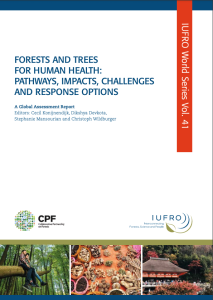The Health and Wellbeing Effects of Forests, Trees and Green Space
Citation
Davand, P., de Vries, S., Bauer, N., Dayamba, D. S., Feng, X., Morand, S., … & van den Bosch, M. (2023). The Health and Wellbeing Effects of Forests, Trees and Green Space. In Forests and Trees for Human Health: Pathways, Impacts, Challenges and Response Options: A Global Assessment Report (pp. 78-124). IUFRO.
Abstract
 This chapter provides an overview of the empirical evidence regarding the association between green space in general, and forests and trees in particular, and health outcomes. The evidence is organised by life stage, and within the three life stages – early life (Section 3.2.), adulthood (Section 3.3.) and the elderly (Section 3.4.) – by type of health outcome. At the end of each of these three sections, the strength of the evidence for the presence (or absence) of a beneficial or detrimental association for a particular health outcome, as assessed by the authors, is summarised. Section 3.6. is devoted to modifiers of the aforementioned associations, such as gender, ethnicity and socio-economic status. In the next section (3.7.), the evidence is placed in the context of global health challenges through elaborating on the potential of green space, and forests and trees in particular, in tackling major contributors to the global burden of disease. The final section concludes that the available evidence already strongly supports a wide range of beneficial associations including neurodevelopment in children, mental health and wellbeing, spiritual wellbeing and cardiometabolic health in adults, and mental health and wellbeing, cognitive ageing and longevity in the elderly. However, this evidence is predominantly based on studies on the health and wellbeing effects of green space, and the available evidence for such effects for forests and trees is still limited for most health outcomes. Moreover, these studies have been mainly conducted in high-income countries, with their generalisability to low- and middle-income countries not being self-evident. Furthermore, the causality of the observed associations is not always clear. Nevertheless, given that many of the involved health outcomes are among the major contributors of the global burden of disease, forests, trees and green spaces have a great potential for improving health and wellbeing of humans across all life stages in our rapidly urbanising world
This chapter provides an overview of the empirical evidence regarding the association between green space in general, and forests and trees in particular, and health outcomes. The evidence is organised by life stage, and within the three life stages – early life (Section 3.2.), adulthood (Section 3.3.) and the elderly (Section 3.4.) – by type of health outcome. At the end of each of these three sections, the strength of the evidence for the presence (or absence) of a beneficial or detrimental association for a particular health outcome, as assessed by the authors, is summarised. Section 3.6. is devoted to modifiers of the aforementioned associations, such as gender, ethnicity and socio-economic status. In the next section (3.7.), the evidence is placed in the context of global health challenges through elaborating on the potential of green space, and forests and trees in particular, in tackling major contributors to the global burden of disease. The final section concludes that the available evidence already strongly supports a wide range of beneficial associations including neurodevelopment in children, mental health and wellbeing, spiritual wellbeing and cardiometabolic health in adults, and mental health and wellbeing, cognitive ageing and longevity in the elderly. However, this evidence is predominantly based on studies on the health and wellbeing effects of green space, and the available evidence for such effects for forests and trees is still limited for most health outcomes. Moreover, these studies have been mainly conducted in high-income countries, with their generalisability to low- and middle-income countries not being self-evident. Furthermore, the causality of the observed associations is not always clear. Nevertheless, given that many of the involved health outcomes are among the major contributors of the global burden of disease, forests, trees and green spaces have a great potential for improving health and wellbeing of humans across all life stages in our rapidly urbanising world